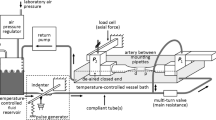Summary
The present study constitutes an effort to close the gap still existing between in vivo and in vitro experiments in vascular mechanics. Active and passive mechanical properties of the rat tail artery were studied in situ under conditions as close as possible to the natural in vivo state of the vessel.
At constant pressure levels, changes in diameter as caused after dilatation by papaverine and constriction by norepinephrine, were automatically and continuously registered using a contact free measurement technique (Video dimension Analyzer).
In order to check consistency of the in situ findings with analogous results from in vitro studies, pressure-diameter and stress-strain data were compared with results from our own and other authors. The results show that, quite similarly to in vitro, the maximum isobaric response of the tail artery in situ occurs in the physiological pressure range of some 100 mm Hg. Although the results focus the attention on the importance of both the experimental protocols and the definitions used, they confirm the validity of in vitro investigations as a powerful tool in arterial rheology.
Similar content being viewed by others
References
Arndt JO, Stegall HF, Wicke HJ (1971) Mechanics of the aorta in vivo. A radiographic approach. Circulation Res 28:693–704
Benninghof A (1927) Über die Beziehung zwischen elastischem Gerüst und glatter Muskulatur in der Arterienwand und ihre funktionelle Bedeutung. Z Zellforsch Mikroskop Anat 6:348–396
Busse R, Bauter RD, Schabert A, Summa Y, Bumn P, Wetterer E (1979) The mechanical properties of exposed human common carotid arterics in vivo. Basic Res Cardiol 74:545–554
Busse R, Sturm K, Schabert A, Bauer RD (1982) The contribution of the parallel and series elastic components to the dynamic properties of the rat tail artery under two different smooth muscle tones. Pflügers Arch 393:328–333
Cox RH (1982) Changes in arterial wall properties during development and maintenance of renal hypertension. Am J Physiol 242:H477-H484
Dobrin PB (1983) Vascular mechanics. In: Shepherd JT, Abboud FM (eds) Handbook of Physiology. The Cardiovascular System. Am Physiol Soc, sect 2, Vol III, chapt 3, pp 65–102
Folkow B, Hallbäck M, Lundgren Y, Sivertsson R, Weiss L (1973) Importance of adaptive changes in vascular design for establishment of primary hypertension studied in man and in spontaneously hypertensive rats. Circ Res 32 (Suppl 1):2–16
Weizsäcker HW, Pascale K (1981) Passive mechanical properties of arteries in relation to topography. Pflügers Arch 391:R10
Weizsäcker HW, Lambert H, Pascale K (1983) Analysis of the passive mechanical properties of rat carotid arteries. J Biomech 16:703–715
Author information
Authors and Affiliations
Rights and permissions
About this article
Cite this article
Pascale, K., Weizsäcker, H.W. In situ study of active and passive mechanical properties of rat tail artery. Basic Res Cardiol 82, 66–73 (1987). https://doi.org/10.1007/BF01907054
Received:
Issue Date:
DOI: https://doi.org/10.1007/BF01907054




